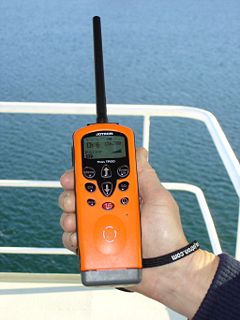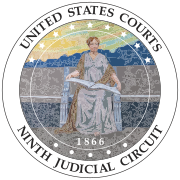
Wi-Fi or WiFi, is a family of wireless network protocols, based on the IEEE 802.11 family of standards, which are commonly used for local area networking of devices and Internet access, allowing nearby digital devices to exchange data by radio waves. These are the most widely used computer networks in the world, used globally in home and small office networks to link desktop and laptop computers, tablet computers, smartphones, smart TVs, printers, and smart speakers together and to a wireless router to connect them to the Internet, and in wireless access points in public places like coffee shops, hotels, libraries and airports to provide the public Internet access for mobile devices.
Telephone tapping is the monitoring of telephone and Internet-based conversations by a third party, often by covert means. The wire tap received its name because, historically, the monitoring connection was an actual electrical tap on the telephone line. Legal wiretapping by a government agency is also called lawful interception. Passive wiretapping monitors or records the traffic, while active wiretapping alters or otherwise affects it.

Wireless communication is the transfer of information between two or more points that do not use an electrical conductor as a medium for the transfer. The most common wireless technologies use radio waves. With radio waves, intended distances can be short, such as a few meters for Bluetooth or as far as millions of kilometers for deep-space radio communications. It encompasses various types of fixed, mobile, and portable applications, including two-way radios, cellular telephones, personal digital assistants (PDAs), and wireless networking. Other examples of applications of radio wireless technology include GPS units, garage door openers, wireless computer mouse, keyboards and headsets, headphones, radio receivers, satellite television, broadcast television and cordless telephones. Somewhat less common methods of achieving wireless communications include the use of other electromagnetic wireless technologies, such as light, magnetic, or electric fields or the use of sound.
The Computer Fraud and Abuse Act of 1986 (CFAA) is a United States cybersecurity bill that was enacted in 1986 as an amendment to existing computer fraud law, which had been included in the Comprehensive Crime Control Act of 1984. The law prohibits accessing a computer without authorization, or in excess of authorization. Prior to computer-specific criminal laws, computer crimes were prosecuted as mail and wire fraud, but the applying law was often insufficient.
The Communications Assistance for Law Enforcement Act (CALEA), also known as the "Digital Telephony Act," is a United States wiretapping law passed in 1994, during the presidency of Bill Clinton.

The Electronic Communications Privacy Act of 1986 (ECPA) was enacted by the United States Congress to extend restrictions on government wire taps of telephone calls to include transmissions of electronic data by computer, added new provisions prohibiting access to stored electronic communications, i.e., the Stored Communications Act, and added so-called pen trap provisions that permit the tracing of telephone communications . ECPA was an amendment to Title III of the Omnibus Crime Control and Safe Streets Act of 1968, which was primarily designed to prevent unauthorized government access to private electronic communications. The ECPA has been amended by the Communications Assistance for Law Enforcement Act (CALEA) of 1994, the USA PATRIOT Act (2001), the USA PATRIOT reauthorization acts (2006), and the FISA Amendments Act (20
Lawful interception (LI) refers to the facilities in telecommunications and telephone networks that allow law enforcement agencies with court orders or other legal authorization to selectively wiretap individual subscribers. Most countries require licensed telecommunications operators to provide their networks with Legal Interception gateways and nodes for the interception of communications. The interfaces of these gateways have been standardized by telecommunication standardization organizations. As with many law enforcement tools, LI systems may be subverted for illicit purposes.

United States v. Councilman, 373 F.3d 197, reversed en banc, 418 F.3d 67, was a criminal case involving interception of e-mail while in temporary storage en route to its final destination. Earlier rulings in the case had raised concerns about the privacy of e-mail and the effectiveness of the Electronic Communications Privacy Act of 1986 (ECPA).

NSA warrantless surveillance — also commonly referred to as "warrantless-wiretapping" or "-wiretaps" — refers to the surveillance of persons within the United States, including U.S. citizens, during the collection of notionally foreign intelligence by the National Security Agency (NSA) as part of the Terrorist Surveillance Program. In late 2001, the NSA was authorized to monitor, without obtaining a FISA warrant, the phone calls, Internet activity, text messages and other communication involving any party believed by the NSA to be outside the U.S., even if the other end of the communication lay within the U.S.

The following is a section summary of the USA PATRIOT Act, Title II. The USA PATRIOT Act was passed by the United States Congress in 2001 as a response to the September 11, 2001 attacks. Title II: Enhanced Surveillance Procedures gave increased powers of surveillance to various government agencies and bodies. This title has 25 sections, with one of the sections containing a sunset clause which sets an expiration date, 31 December 2005, for most of the title's provisions. On 22 December 2005, the sunset clause expiration date was extended to 3 February 2006.

The Terrorist Surveillance Program was an electronic surveillance program implemented by the National Security Agency (NSA) of the United States in the wake of the September 11, 2001 attacks. "The program, which enabled the United States to secretly track billions of phone calls made by millions of U.S. citizens over a period of decades, was a blueprint for the NSA surveillance that would come after it, with similarities too close to be coincidental". It was part of the President's Surveillance Program, which was in turn conducted under the overall umbrella of the War on Terrorism. The NSA, a signals intelligence agency, implemented the program to intercept al Qaeda communications overseas where at least one party is not a U.S. person. In 2005, The New York Times disclosed that technical glitches resulted in some of the intercepts including communications which were "purely domestic" in nature, igniting the NSA warrantless surveillance controversy. Later works, such as James Bamford's The Shadow Factory, described how the nature of the domestic surveillance was much, much more widespread than initially disclosed. In a 2011 New Yorker article, former NSA employee Bill Binney said that his colleagues told him that the NSA had begun storing billing and phone records from "everyone in the country."

Hepting v. AT&T is a United States class action lawsuit filed in January 2006 by the Electronic Frontier Foundation (EFF) against the telecommunications company AT&T, in which the EFF alleges that AT&T permitted and assisted the National Security Agency (NSA) in unlawfully monitoring the communications of the United States, including AT&T customers, businesses and third parties whose communications were routed through AT&T's network, as well as voice over IP telephone calls routed via the Internet.

Room 641A is a telecommunication interception facility operated by AT&T for the U.S. National Security Agency, as part of its warrantless surveillance program as authorized by the Patriot Act. The facility commenced operations in 2003 and its purpose was publicly revealed in 2006.
Arthur Robert Firstenberg is an American author and activist on the subject of electromagnetic radiation and health. He is the founder of the independent campaign group the Cellular Phone Task Force. His 1997 book Microwaving Our Planet: The Environmental Impact of the Wireless Revolution was published by the group. He is the author of The Invisible Rainbow: A History of Electricity and Life.

The Stored Communications Act is a law that addresses voluntary and compelled disclosure of "stored wire and electronic communications and transactional records" held by third-party internet service providers (ISPs). It was enacted as Title II of the Electronic Communications Privacy Act of 1986 (ECPA).
Privacy advocates have objected to the Google Street View feature, pointing to photographs that show people leaving strip clubs, protesters at an abortion clinic, sunbathers in bikinis, cottagers at public parks, people picking up prostitutes, and people engaging in activities visible from public property which they do not wish to be photographed and have published online. Google maintains that the photos were taken from public property. However, this does not take into account that the Street View cameras take pictures from an elevated position, enabling them to look over hedges and walls designed to prevent some areas from being open to public view. Before launching the service, Google removed photos of domestic violence shelters, and additionally allows users to flag inappropriate or sensitive imagery for Google to review and remove. When the service was first launched, the process for requesting that an image be removed was not trivial. Google changed its policy to make removal more straightforward, but has since removed the option to request removal of an image, replacing it by an option to request blurring of an image. Images of potential break-ins, sunbathers, and individuals entering adult bookstores have, however, remained active and these images have been widely republished.

Konop v. Hawaiian Airlines, Inc., 236 F.3d 1035 (2001) was a case in which the United States Court of Appeals for the Ninth Circuit affirmed in part and overturned in part the ruling of the United States District Court for the Central District of California. The court held that the defendant, Hawaiian Airlines, could not be held liable for violation of the federal Wiretap Act when it gained access to the plaintiff's website because the contents of the plaintiff's website were in storage, and thus could not be intercepted under the meaning of the Wiretap Act.
The third-party doctrine is a United States legal doctrine that holds that people who voluntarily give information to third parties—such as banks, phone companies, internet service providers (ISPs), and e-mail servers—have "no reasonable expectation of privacy" in that information. A lack of privacy protection allows the United States government to obtain information from third parties without a legal warrant and without otherwise complying with the Fourth Amendment prohibition against search and seizure without probable cause and a judicial search warrant.
Google has been involved in multiple lawsuits over issues such as privacy, advertising, intellectual property and various Google services such as Google Books and YouTube. The company's legal department expanded from one to nearly 100 lawyers in the first five years of business, and by 2014 had grown to around 400 lawyers. Google's Chief Legal Officer is Senior Vice President of Corporate Development David Drummond.
Google's changes to its privacy policy on March 16, 2012 enabled the company to share data across a wide variety of services. These embedded services include millions of third-party websites that use AdSense and Analytics. The policy was widely criticized for creating an environment that discourages Internet-innovation by making Internet users more fearful and wary of what they put online.









